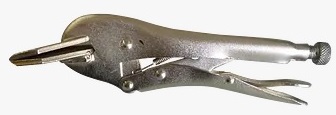Essential Garden Edging Tools
Want to make your garden edging installation a breeze? While there are various tools available, we’ve curated a list based on our hands-on experience with corten steel edging. Remember, the perfect toolkit is a blend of your preference, expertise, and the task at hand.


Rubber Mallet (1.2kg)
A rubber mallet is essential for driving in stakes and adjusting garden edging. It provides the right amount of force without causing damage, ensuring your edging is securely in place. Its soft head ensures that the materials aren’t marred or dented during use.
Dead Blow Hammer (1.65kg)
Designed for efficient stake driving and edging height adjustment, the dead blow hammer delivers force without a rebound. Its weight ensures garden stakes are driven securely, especially in larger projects. The design minimizes the chance of damaging the surrounding area.


Rubber Forming Strip
The rubber forming strip is a game-changer for those aiming to shape the edging without causing kinks, especially for makeshift garden rings and tight curves. It aids in achieving the desired shape for intricate garden designs. It’s flexible and easy to maneuver, making it a favorite among garden enthusiasts.
Wide Brimmed Vice Grip
This tool is perfect for holding connector pieces and stakes securely during installation. It ensures that the connectors and stakes stay in place, making the process smoother. Its adjustable grip strength ensures a firm hold without causing damage.


8mm Magnetic Hex Head Driver
An essential tool for securing garden edging with self-tapping screws, it ensures that screws are driven in securely, keeping the edging intact. The magnetic tip helps in holding the screw in place, reducing the chances of slipping.
Cold Gal Spray Paint
For those wanting to ensure the longevity of their garden edging, the cold gal spray paint protects exposed metal areas with a protective zinc coating, preventing rust. It dries quickly and provides a smooth finish, enhancing the overall appearance


Drill
A drill is crucial for screwing stakes and connectors to the edging. It ensures all parts are securely fastened, guaranteeing the durability of your garden edging. Modern drills offer adjustable speed settings, allowing for precision and control.
String Line, Chalk, or Marking Paint
Achieve a flawless layout with these tools, perfect for marking out straight lines and precise designs. They ensure your garden edging looks professional and well-planned. Using bright colors can help in better visibility during the installation process.


Angle Grinder or Hack Saw
Whether ending a line or adjusting the length, these tools are essential for cutting the edging at desired lengths. They ensure clean cuts for a neat finish. Always wear safety goggles when using these to protect your eyes from debris.
Metal File
After cutting your edging, a metal file is indispensable for smoothing out sharp edges, ensuring safety and a polished look. Regular filing can also help in maintaining the longevity of your edging.


Spade, Pick Axe, or Hand Mattock
Loosening the soil before laying edging is crucial, and these tools ensure the ground is ready to accommodate your garden edging seamlessly. Properly loosened soil also promotes better plant growth around the edges.
Square
For a professional look, a square tool is essential to ensure cuts are perfectly square, leading to a seamless join. It’s a small tool, but it plays a significant role in achieving a neat finish.


Pen
A simple yet vital tool, a pen is used for marking the edging before cutting or noting design specifics. Always keep one handy to jot down measurements or design ideas on the go.
Tape Measure
Measuring and planning the installation is the first step to a successful garden edging project. A tape measure ensures you have the right amount of material and aids in layout planning. A retractable one can be easily stored and carried around.


Rivet Gun
For a polished finish, a rivet gun is used to provide a cleaner look with rivets, ensuring that the edging pieces are securely joined without visible screws. Rivets also add an aesthetic touch, giving a neat appearance to the joints.
More DIY Guides
From intricate landscaping projects to simple garden hacks, delve deeper into a world of hands-on creativity. Each guide is packed with expert advice, ensuring that your next DIY endeavor not only meets but exceeds expectations.
Profile Heights
Understanding profile heights is crucial for achieving the desired look and functionality in garden edging.
DIY Garden Edging Guide
Whether you’re a seasoned landscaper or a DIY enthusiast, our comprehensive guides cover every facet of garden edging.



